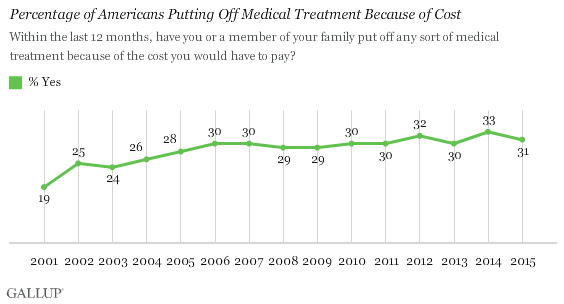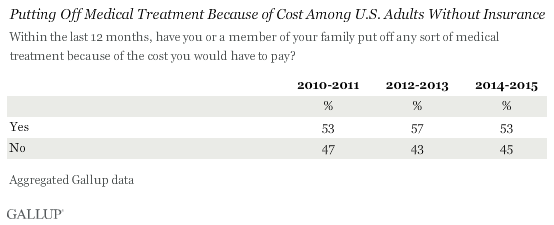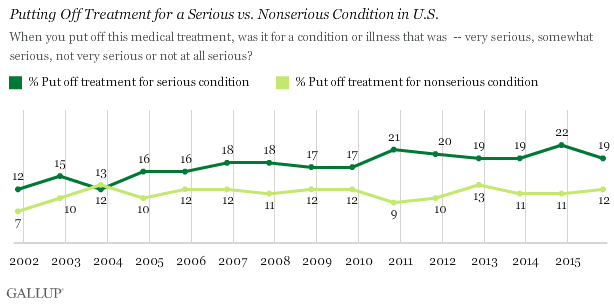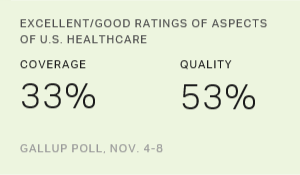Story Highlights
- 31% have delayed medical care because of cost, unchanged from 2014
- Figure has not fallen since ACA reforms
- Americans more likely to put off care for serious condition
WASHINGTON, D.C. -- Slightly fewer than one in three Americans (31%) say that they or a family member have put off any sort of medical treatment in the past year because of the cost. This is essentially unchanged from the 33% who said this in 2014, and the figure has remained steady for the past decade. The majority of Americans (68%) say they did not have to put off care because of the cost.

These results come from Gallup's annual Health and Healthcare poll, conducted Nov. 4-8. In recent years, Americans have consistently cited healthcare cost as one of the top two "most urgent health problems" facing the U.S., and fewer than one in four Americans are satisfied with the cost of healthcare nationally. Since 2001, at least 19% of Americans -- and much closer to a third beginning in 2006 -- have found the cost of some healthcare services so prohibitive that they or a family member has had to postpone a medical procedure.
The 2010 Affordable Care Act had the twin objectives of expanding health insurance to cover the uninsured and making healthcare more affordable. The Gallup-Healthways Well-Being Index has found that the uninsured rate has fallen considerably since the law was passed. In the third quarter of 2015, the rate stood at 11.6%, compared with 16.4% in early 2010.
Given these goals and the apparent success of the law in accomplishing the former, it would seem logical for fewer national adults to report that they or a family member has delayed medical treatment simply because of cost. But this has not happened; instead, the percentage has held statistically constant since the law was passed in 2010.

While the uninsured rate has declined, a little over one in 10 still are without health insurance. Not surprisingly, this group is especially sensitive to healthcare costs, with 53% of those interviewed in 2014 or 2015 -- i.e., the post-mandate period -- saying they have had to forgo medical care. This rate is comparable to figures from aggregated samples in 2012-2013 and 2010-2011, when the number of uninsured adults was much greater. This suggests that those who remain uninsured over the last two years are not systematically different in this regard than in the past, despite their dwindling numbers.

Americans Still More Likely to Put Off Care for Serious Conditions
As has been the case nearly every year that Gallup has asked this question, Americans who put off treatment are more likely to say they did this for a serious condition (19%) than a nonserious one (12%). Nationally, the share of adults saying they were delaying treatment for a serious condition has climbed since this question was first asked in 2001, reaching a record 22% last year before edging down to 19% this year. Conversely, the percentage of U.S. adults putting off treatment for a nonserious condition has remained relatively stable.

Bottom Line
A major aim of the ACA is to make healthcare affordable for all Americans, by requiring individuals to have health insurance and barring insurance companies from denying coverage to those with pre-existing conditions. The law has other provisions that are designed to limit the cost of healthcare services, but despite all these measures, a consistent third of the country say that in the past year, they or their family has had to delay medical treatment. The ACA has achieved objectives considered important by the policymakers who crafted the law -- most notably, ensuring that a greater a number of Americans have medical insurance -- but on this cost-related metric, its influence has not been felt.
These historical data are available in Gallup Analytics.
Survey Methods
Results for this Gallup poll are based on telephone interviews conducted Nov. 4-8, 2015, with a random sample of 1,021 adults, aged 18 and older, living in all 50 U.S. states and the District of Columbia. For results based on the total sample of national adults, the margin of sampling error is ±4 percentage points at the 95% confidence level. All reported margins of sampling error include computed design effects for weighting.
Each sample of national adults includes a minimum quota of 60% cellphone respondents and 40% landline respondents, with additional minimum quotas by time zone within region. Landline and cellular telephone numbers are selected using random-digit-dial methods.
View complete question responses and trends.
Learn more about how Gallup Poll Social Series works.


